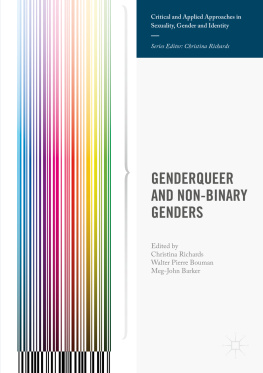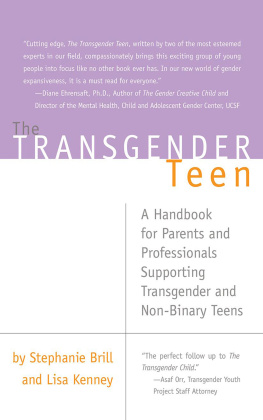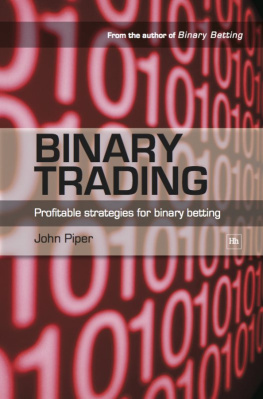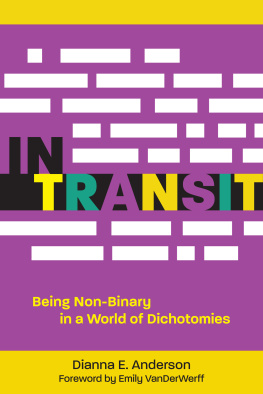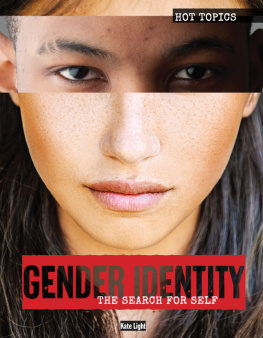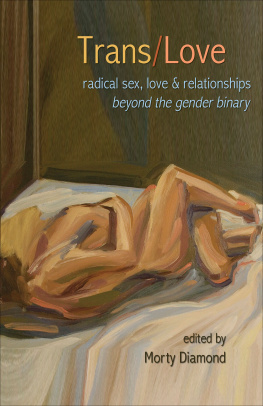1. Introduction
Introduction
This book has been hard to bring to publication. One of the first problems we came across was that the authors did not know what to writeor rather they did know, but did not know that they knew, as it were. But no ones written on this before, people would say, and, in general, they were correct. There was no jumping-off pointno Here is the literature and here is how I am adding to it, no body of work to form a firm ground from which to leap. It is notable, however, that things have changed during the time that we have been editing the book, beginning with what we believe to be the first academic conference specifically on non-binary gender in the Spring of 2016 (Vincent & Erikainen, ).
However, given the dearth of existing literature, in some senses, the authors in this volume are the giants upon whose shoulders others may stand. But while there have been no direct antecedents to the work here, there are, of course, many whose work has informed and inflected it. The surgical techniques developed for others which have been adapted for this population; the psychological modalities adjusted to suit; andfar more so than in the other fieldsthe theoretical bases from which academics and theorists may work. There has been work such as Bornsteins (), it would be foolish to assume that non-binary gender is a purely modern phenomenon and so it is to this long movementwhich circles ever back to the truth from the obscuring hand of self-interested powerthat this book seeks to add.
Having decided a book was needed, our main concerns were with language and the structure of the book (cf. Richards & Barker, ). Even the book title evolved over the time of writing as the word genderqueer became more accepted and utilised as another umbrella term for those outside of the gender binaryand was consequently included in the title.
One of the most difficult decisions we had to make concerned how we should entitle the surgery chapters such that readers could find what they were looking for regarding surgery for different body parts and areas, while at the same time minimising incorrect assumptions and offence. Clearly, Surgery for Men would be misleading and inaccurate, whereas Surgery for Non-Binary People would not distinguish the chapters from one another. Surgery for People with a Penis related gender to a single organ too closely, where we wanted to discuss a range of operative proceduresindeed, it also doesnt allow for the range of meanings people attribute to that body part. The least-worst option seemed to be Surgery for Bodies Commonly Gendered as Male ; Surgery for Bodies Commonly Gendered as Female , and so on, shifting the view to the assignations of wider society, rather than our own.
This does feel like a bit of a cop-out, however. It would be nice if there were new terms, Androsome and Gynesome , say, which refer to the two common configurations of body parts developed under common genetic expressionbut which do not assume a cisgender norm; and make no inference regarding meaning or gendereither of the configuration or of the individual parts. Thus, a trans man may be Gynesome, but feel his chest is incorrect and have surgery to address it. He may feel his genitals are acceptable and that, as they are his [male] genitals, they should properly be called a manhole. A non-binary person might also be Gynesome and feel that their genitals are acceptable in that they regard them as being feminine and that they fit with the degree of femininity which is suitable for them. This non-binary person may also wish to have chest surgery to effect the correct chest contour for their sense of self. Additionally, a cisgender woman might be Gynesome in that she has a vagina, ovaries, and breastsand further she may clarify that she is content with these and views them as a signifier of her femininity, or she may seek breast augmentation surgery to effect a better chest contour for her sense of self. Thus, we split the body parts from the meaning; allow multiple meanings and options for change as required; but also have some method of communication about commonly found bodily configurations and parts which make no a priori assumptions. Our hope is that by the time of a second edition of this book, society, and the language it uses, will have moved so that the words we use are generally understood in this way.
We also made few allowances for readers unfamiliar with technical terms. With the Internet ready to handindeed with some e-readers having inline lookup functionsit feels unnecessary to continually define terms. In part, this was because we wanted the book to be technically specific, rather than being for a very general readeralthough general readers should find much to interest them, and hopefully not overmuch they need to search online to define. Further, we wanted different sections of the book to be of interest to specific professions, and it feels unreasonable to ask surgeons to define simple surgical terms for the non-surgical reader when their surgical colleagues will read the chapter; or queer theory academics to do the same. Hopefully, people reading cross-discipline will enjoy the dip into another world.
The next issue concerned how best to split the book such that it has an accessible structure for all readers. We therefore decided to split it into three main sections, which nominally represented the rough areas of endeavour concerning non-binary and genderqueer folkthese being Societies , Minds , and Bodies . This covers the usual biopsychosocial approach to human being, but also highlights our main omission Spiritualities which will therefore be addressed in future editions as non-[gender]binary aspects of spirituality may be found in most major religions and a vast number of spiritual practices (cf. Richards, ). Therefore, the sections of the book are as follows:
In the Societies section, S. Bear Bergman and Meg-John Barker wrote on Activism and its place in moving the whole field forward; Ben Vincent and Ana Manzano-Santaella wrote about History and Cultural Diversity , giving an excellent overview of how gender has been understood across time and space in a way which alerts us to the unusual status of the current high GDP Western understanding of gender as a binary opposite; Rob Clucas and Stephen Whittle detail the current legal position in Law ; and Jay Stewart eloquently explains Academic Theory in this area. In the Minds section, we, as editors and colleagues, each took our specialty, with Meg-John Barker and Alex Iantaffi exploring Psychotherapy with non-binary people; Christina Richards meditating on the philosophy and practice of Psychology ; and Sarah Murjan and Walter Pierre Bouman giving a thoughtful overview of Psychiatry . In the Bodies section, Leighton Seal explains what may and may not be done in Adult Endocrinology ; with Gary Butler similarly detailing this for Child Endocrinology . James Bellringer explains what genital surgical options are available in Surgery for Bodies Commonly Gendered as Male ; David Ralph, Nim Christopher, and Giulio Garaffa similarly examine genital surgical options in Surgery for Bodies Commonly Gendered as Female ; Andrew Yelland then explains surgical possibilities in Breast Surgery ; and finally, Alex Iantaffi considers where we might go from here in Future Directions .

